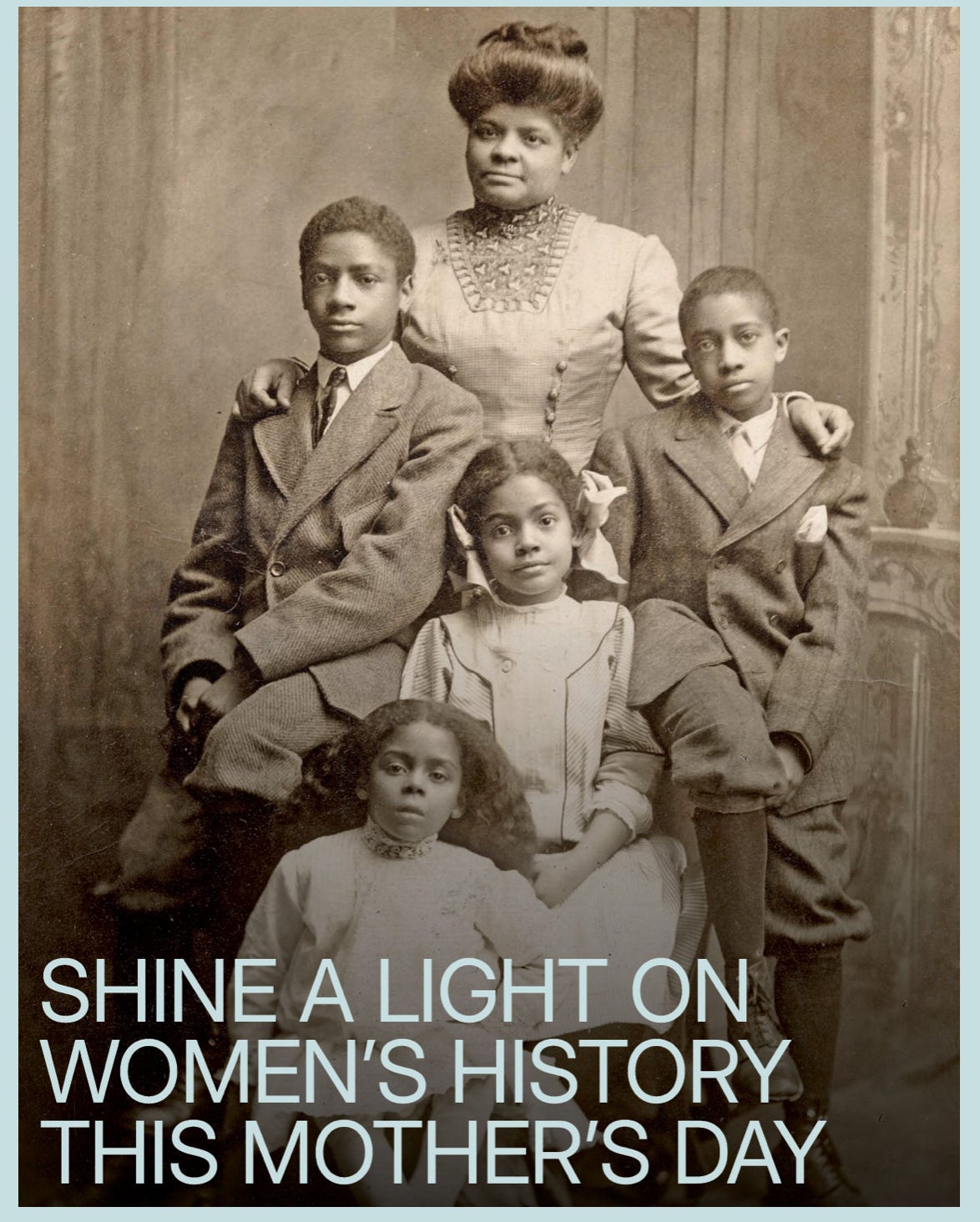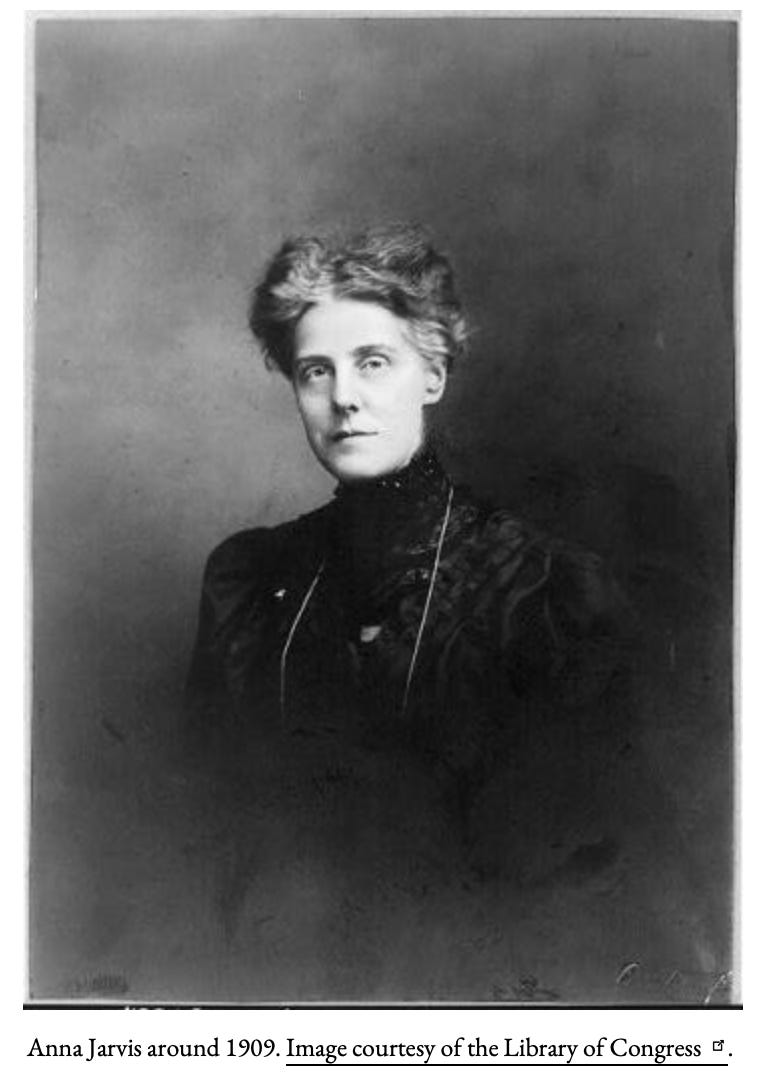PRONATALISM: a political ideology which promotes reproduction, or . . . more aptly, sees women’s primary role as giving birth in order to promote a country’s native population. (www.populationmedia.org)
On Mother’s Day, American moms, and “other moms,” including stepmothers and godmothers, are celebrated with cards, bouquets and breakfast in bed. The holiday has become one of the most profitable in America, with consumers expected to spend $33.5 billion, according to the National Retail Association. Mother’s Day has also become an occasion to raise money, to support both Planned Parenthood and anti-abortion organizations. The Smithsonian National Women’s History Museum suggested donors honor their mothers by making a gift to the museum.
IDA B. WELLS and her children, 1909 (NMWH)
Not every woman celebrates. It can be heartbreaking for women whose children have died, who have suffered miscarriages, whose IVF treatment failed; people whose mothers are dead, who are estranged, who have been unable to adopt or are searching for birth mothers; women who might regret not becoming mothers or do not have access to the medical care that would help them terminate a pregnancy, on account of rape, incest or because of their marital, economic or educational situation.
Until the 1850s, it was legal and commonplace in America to end a pregnancy until the twenty-fourth week. In countries with high and racially disparate maternal mortality rates, like the United States, becoming a mother could result in death. From forever, women have risked their lives to bear children.
Celebrating maternal fertility was a spring ritual across centuries, cultures and continents. Women have been prized for their capacity to bear children and secure survival of the species. Ancient Egyptians honored Isis, the loving mother-goddess, often depicted holding baby Horus, like Mary and Jesus in Christian iconography. The cult of a great mother-goddess spread from Turkey to Greece and Rome.
Words relating to mother evolved from Latin, mater for mother and matrix for uterus, as well as matriarchy, matrimony, alma mater, metropolis (mother city) and marigold (mari, mother of God). The verb to mother is to give birth or to nurture; the noun refers to a female parent, a woman in authority, the primary source (mothers of invention) or something ultimate (the mother of all strollers).
With the rise of Christianity, the Catholic Church set aside the fourth Sunday in Lent as a day to celebrate the Virgin Mary, the “mother church” and mothers. Families spent the day together, servants were given the day off and an exception was made to Lenten fasting. England still celebrates Mothering Day on that moveable date. The Puritans objected to how secular the holiday had become and abandoned it in colonial America.
Mothers Day, without an apostrophe, was reintroduced here in the 1870s, not to honor mothers but to elevate their role in political discourse. Julia Ward Howe, who wrote the Battle Hymn of the Republic, was horrified by the carnage of the Civil War and the Franco-Prussian War. She proposed an international day to protest war and the massacre of mothers’ sons everywhere, but her effort to establish an annual June 2 Mothers Day of Peace failed.
Anna Jarvis (1864-1948) deserves credit for Mother’s Day as we know it. She wanted to honor her beloved mother, Ann Reeves Jarvis (1832-1905), a Sunday school teacher who bore at least twelve children. Many of them died from measles and diphtheria, diseases common in mid-nineteenth-century Appalachia. Mrs. Jarvis organized women to improve their community. After the Civil War, in what became West Virginia, Mrs. Jarvis worked to connect mothers of Union and Confederate soldiers. She wanted to honor all mothers for their “matchless service.”
After her mother died on May 10, 1905, Anna decided to honor her on the second Sunday of May. In 1907, she distributed 500 white carnations to each mother attending St. Andrews Episcopal Church in Grafton, WV, and urged their children to write notes of gratitude. In 1912, West Virginia became the first state to mark Mother’s Day. President Wilson proclaimed the first national Mother’s Day in 1914. Australia, Denmark, Italy, Japan, Turkey and Venezuela also salute mothers today.
Jarvis was alarmed by the holiday’s immediate commercialization. “I wanted it to be a day of sentiment, not profit.” She organized protests, threatened lawsuits, wrote letters to editors, demanded audiences with presidents and harangued Eleanor Roosevelt, to no avail. Independent, indefatigable and childless, Jarvis made Mother’s Day her life’s work. She exhausted her inheritance, lost her sight and died in a sanitarium in 1948. Her care was secretly underwritten by the Florists Exchange.
Motherhood gave women moral authority. They were prized for performing a primary biological function. In our country’s first decades, “Republican Mothers” were called upon to safeguard our democracy by educating their sons in citizenship. In the 1830s, the “Cult of True Womanhood” expected middle-class white women to be “pious, pure, submissive and domestic,” occupying a “separate sphere” of marriage and motherhood. The ante-bellum South mythologized enslaved mammies, women who cared for the master’s children, while their own children, frequently the products of rape, increased the property holdings of their white fathers.
One of the “great race women” of her era, Anna Julia Cooper published a feminist track in 1892. A childless widow who fostered many children, she asserted that motherhood gave women “self-authority, self-interest and self-identity.” In an era in which women had no legal, political or economic power, the public’s respect for “Virtuous Womanhood” empowered both Black and white activists.
Childless suffragists made the case that the “mothers of the race” deserved the vote. After opposing a federal suffrage amendment (and promising to keep their sons out of the Great War), Wilson finally supported voting rights for women as a war measure, to reward the patriotism and sacrifice of American mothers.
Historically American women had lots of children (Elizabeth Cady Stanton had seven; her mother had eleven; Margaret Sanger’s mother had eighteen). There was no reliable contraception, infant mortality was high (half of all children died before they were five), marital rape was legal and spinsters were stigmatized. Women had few alternatives outside marriage. Families had babies because they needed additional farm workers or wage earners. Impoverished immigrant women self-aborting with knitting needles and lye propelled Sanger to launch the birth control movement.
Nineteenth-century American men considered anything that undercut fertility among “native” (meaning white Protestant) women a threat. The American Medical Association’s successful campaign to criminalize abortion in every state after 1860 was a response to a surge in Irish and German Catholic immigration, when the term “white replacement” was used for the first time. Promoting pronatalism, and to stay in business, obstetricians condemned married women who had limited the size of their families, with widely advertised abortifacients.
Increased access to higher education for girls after the Civil War posed another threat to fertility. In 1872, Edward Clarke, a professor at the Harvard Medical School, declared that using thinking would make women infertile, redirecting vital energy from their ovaries to their brains, and diminish their childbearing capacity. The newly formed American Association of University Women, whose members were college graduates, funded research which refuted Clark’s claims.
It was true, however, that going to college delayed marriage and motherhood for several years, which might result in fewer children. Education also offered alternatives to marriage, in newly established professions.
While immigrants contributed to the country’s population growth, elites worried about who was having babies. Theodore Roosevelt, the father of six, whose first wife died in childbirth, encouraged his privileged social cohort to have more children. Such attitudes contributed to the eugenics movement of the early twentieth century.
As early as 1824, English economist Thomas Malthus predicted that population growth would out pace food production. Only “vice” (war), “misery” (famine) or “moral restraint” (abstinence) would limit population growth. Even adding genocide, natural disasters and pandemics to that list, population expanded. Around 1970, alarm about unrelenting increases prompted India to subject millions to compulsory sterilization and China to enforce its one-child policy. No one anticipated that the birth-rate would slowdown.
The birth or fertility rate measures the number of children women will bear in their lifetimes. In the US, the birth rate was 3.3 in 1920. During the Depression, it dropped to 2.0, the “replacement rate.” From 1946 to 1964, during the postwar “Baby Boom,” it rose to 3.5. It reached a low point of 1.7 in 1979. It recovered a bit, sank again with the 2008 financial crisi and reached a record low of 1.69 in 2023, as recently reported.
Many factors contributed to the change. Access to more sex education and birth control produced a dramatic drop teenage pregnancy. Data for 2019 recorded a decline to 17.4 per 1000 among girls ages fifteen to nineteen.
The American marriage rate has also declined. In 1920, 92.3 per thousand women were married. In 2020, it was 32.2. One in three adult women has never married. Plus, higher ages of brides, now nearing thirty, lower the number of offspring. Even Mormons and Hispanic Catholics are having fewer babies. Only ultra-Orthodox Jews and the Amish have high fertility rates.
Household demographics have shifted: 28% of Americans live alone; 35% live with roommates or partners; 19% of married couples live with children; 9% are single parents. One in four children do not live with both biological parents. Only 41% of Americans believe that children contribute to marital happiness. More households have dogs than children.
Still, by age forty-four, 86% of American women are mothers. Among them, 41% have two children; 24% have three and 14% have four or more. Those are women with a high school diploma and women with multiple degrees. The proportion of women who have only children doubled from 11% in 1976 to 22% today.
The drop in the birth rate to below replacement will slow global warming, empty schools, fill senior living spaces, shrink the workforce and bankrupt social security. “Declining population,” according to Elon Musk, “threatens civilization.” He’s alarmed that third world people already outnumber educated elites. With at least fourteen offspring born to three or more women, Musk is trying to reverse the trend.
Elon Musk, his son X and President Trump in the Oval Office, February 2025. (White House)
Vice President Vance, father of three, blames this “catastrophic problem” on “childless cat ladies.” Conservative activist Charlie Kirk, dad of two, concurs: “The childless are the ones that are destroying the country.” Social conservatives are calling for a return to traditional family values, as represented by “trad wives.” So-called traditional wives embrace motherhood and domesticity. They reject feminism but are frequently earning high incomes as influencers on social media.
President Trump, father of five children with three wives, wants to be known as the “fertility president” and make IVF treatment free. But last Friday he abolished the arm of the Centers for Disease Control and Prevention (CDC), which analyzed data from fertility clinics to assess and improve their outcomes. Not to mention cutting $1 billion from Head Start programs. The White House has also proposed a $5,000 post-delivery baby bonus and a National Medal of Motherhood for moms with six or more children. Similar prizes were awarded by Hitler and Stalin and have been enacted by Vladimir Putin and Victor Orban.
In the fourteen Republican-controlled states that outlawed abortion, following Dobbs, there are likely no free clinics offering pre-natal care or access to life-saving treatment for women suffering miscarriages. In those states, infant mortality has increased 5.6% overall and 11% among newborn Black babies. Across America, 35% of counties do not have a maternity ward or an obstetrician.
House Speaker Mike Johnson (R-LA) has four children and an adopted Black son who no longer appears in his official biography or family photographs. Recently the “pro-family” legislator killed a bipartisan bill written by two new mothers in Congress. It would have allowed new parents to vote by proxy and access federal family leave benefits from which the Congress is except. A year ago, the House passed a child tax credit bill with bipartisan support; it was defeated in the Senate, as “a new welfare program.” Then-Senator Vance missed the vote.
Without paid family leave and affordable childcare, regular families struggle, especially the 40% of mothers who are primary breadwinners. Universal pre-K and kindergarten, after school and summer programs, telecommuting and flextime would be pro-family public policies. Protecting rather than cutting food assistance would benefit poorer families.
Birthrates have slipped below the replacement level around the globe. Europe’s “demographic winter” has alarmed France’s President Macron and Italy’s Prime Minister Giorgia Meloni. Albania, El Salvador and Nepal are below replacement levels. Japan’s birthrate reached 1.7 twenty years ago. South Korea’s, at 0.7, is the lowest in the world, possibly the lowest in recorded history.
Demographers list multiple causes. Higher levels of education, higher incomes and higher quality of life depress the birthrate and increase life expectancy. Economic uncertainty, job insecurity, political unrest, lack of support for new moms, even rules regarding car seats (more kids means more car seats and a bigger car) have been identified as reasons to have fewer children. Countries with generous parenting policies, like Canada, Japan, South Korea, the EU and Norway, have below replacement birthrates.
Claudia Goldin, who won the 2023 Nobel Prize in economics for her trailblazing research on women in the workforce, looks at global fertility from a macro-economic perspective. Goldin concludes that two factors explain the downward trend in the birthrate: the speed at which women entered the workforce after World War II and the slower pace at which men’s attitudes about gender roles (about who should raise children and keep house) adapted. The issue, Goldin concluded, was “couple equity.”
To increase birth rates, the Romans fined men who were still unmarried at twenty-five. Rather than condemning childless women and couples who choose to have fewer children, or reenacting The Handmaid’s Tale, the US and other countries should brainstorm about how to prepare for a possible lower population future. Maybe it could include fewer children living in poverty or starving in war zones or dying of diseases we know how to prevent.
Having a child is an act of faith, hope and love. So let’s join Anna Jarvis in expressing gratitude and honoring the women in our lives, related or not, who raise us up.
Author’s note to grammarians: I know I have used plural verbs in sentences with percent as the noun. Without apology.
SOURCES
Rachel Seidman, “The History of Mother’s Day: From Global Peace to Greeting Cards,” Smithsonian Magazine (May 1, 2024), https://womenshistory.si.edu/blog/history-mothers-day-global-peace-greeting-cards
“Mother’s Day,” The Writer’s Almanac (May 12, 2013), https://writersalmanac.publicradio.org/index.php%3Fdate=2013%252F05%252F12.html
Elaine Showalter, The Civil Wars of Julia Ward Howe: A Biography (Simon & Schuster, 2016).
Katharine L. Antolini, Memorializing Motherhood: Anna Jarvis and the Struggle for Control of Mother’s Day (West Virginia University Press, 2014).
Birthrate statistics from the Centers for Disease Control and Prevention (https://www.cdc.gov).
Gideon Lewis-Krause, “The End of Children,” The New Yorker (March 3, 2025), https://www.newyorker.com/magazine/2025/03/03/the-population-implosion
Anne Branigin, “The Couple Who Want to Make America Procreate Again,” Washington Post (February 4, 2025), https://www.washingtonpost.com/style/of-interest/2025/02/01/malcolm-and-simone-collins-pronatalism/
Robin Caryn Rabin, “Trump Called for More Babies but Dismissed Fertility Researchers at the C.D.C.,” New York Times (May 7, 2025), https://www.nytimes.com/2025/05/07/health/trump-fertility-ivf-cdc.html
Monica Hesse, “What Trump Doesn’t Know About the Cost of Raising Kids,” Washington Post (April 30, 2025), https://www.washingtonpost.com/opinions/2025/04/30/trump-5k-incentive/
Katherine Clark, “Why Are Birth Rates Low? Ask Republicans,” Washington Post (May 11, 2025), https://www.washingtonpost.com/opinions/2025/05/09/fertility-rate-united-states-trump-republicans/
Jessica Grose, “Stop Panicking About the Birthrate,” New York Times (August 7, 2024), https://www.nytimes.com/2024/08/07/opinion/birthrate-child-tax-credit.html
Heather Long, “A Nobel Prize Winner Decodes Why People Aren’t Having Kids,” Washington Post (February 18, 2025), https://www.washingtonpost.com/opinions/2025/02/18/fertility-decline-women-kids-claudia-goldin/











Why is it a goal to ‘maintain’ the population, when it has mostly constantly increased? Should focus be on ‘rightsizing’ for healthy mixed populations per location & sustainability goals?